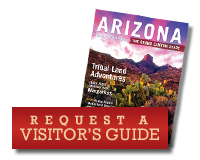Rrrratatat. A Gila woodpecker is my wake-up call – he’s drumming on the balcony of my room at the JW Marriott Starr Pass Resort, tucked in the Tucson Mountains. And I’m glad he got me out of that way-too-comfy bed, as I’m now enjoying a rosy dawn lighting up a forest of saguaros below and listening to a Gambel’s quail raise its lilting, four-note call.
It’s a fabulous start to my Sonoran Desert daytrip. I’m making a kind of instant safari; a drive and hike into cactus country, a spin through a wildlife museum and an arboretum exploration. The JW Marriott Resort makes a perfect base camp – it’s practically next door to my first stop: Saguaro National Park.
Saguaro National Park
Any cool season is the best time to roam Saguaro National Park, the Tucson Mountain segment of this vast two-part park, and I’ve timed my visit right. After a pause at the Red Hills Visitor Center for maps, I stroll the short Desert Discovery Trail and get acquainted with desert denizens like palo verde, ironwood, cholla cactus and the whip-like ocotillo. Next, I turn onto Bajada Loop Drive, a good dirt road accessing trails.
As I climb Signal Hill Trail, a whiptail lizard scurries past a rock etched with swirls and stars: petroglyphs left by the ancients. Atop the hill, more astonishing carvings and a heavenly view await – a vast army of saguaros, arms raised to the skies. The saguaro has been called the monarch of the Sonoran Desert, and to wildlife, it’s supremely important. It’s a multi-story apartment complex for birds such as cactus wren, elf owls and kingbirds who compete for homes in the saguaro’s holes. And in summer, coyotes, foxes, javelinas and others feast on the saguaro’s ripe fruit.
Tucson's Nature Museums
On a short trip like this, there’s only one stop for slam-dunk wildlife sightings: the nearby Arizona-Sonora Desert Museum. It’s a celebration of Sonoran diversity, and an easy way to spot javelinas, cougars and bighorn sheep. I grab a light lunch at the museum’s small café, then race to catch a Raptor Free Flight demonstration (November through April) and watch owls whirl overhead. At the walk-through hummingbird aviary, a rainbow of birds zoom about – Western tanagers, yellow grosbeaks, blue-rumped parrotlets. But one sight enchants me: a broad-billed hummingbird, sitting atop a nest the size of a golf ball.
Heading back down the mountain, I pause at Tucson's self-proclaimed natural history museum, the International Wildlife Museum. I’m sorry my bug-loving little nephew isn’t here – he’d adore the exotic mounted butterflies and the display called, ahem, “Scat, the Inside Story.”
Heading back to Tucson, I make my last stop the Tucson Botanical Gardens, near downtown. It’s a cool little 5½-acre oasis of 16 mini-gardens and a special garden for kids. As I’m sitting by the carefully tended cactus and succulent garden, a movement catches my eye. Atop the fence sits a gilded flicker, another common Southwestern woodpecker. In the still, warm air, his rapid wik-wik-wik call is like a signal, telling me it’s time to end my desert daytrip safari.



